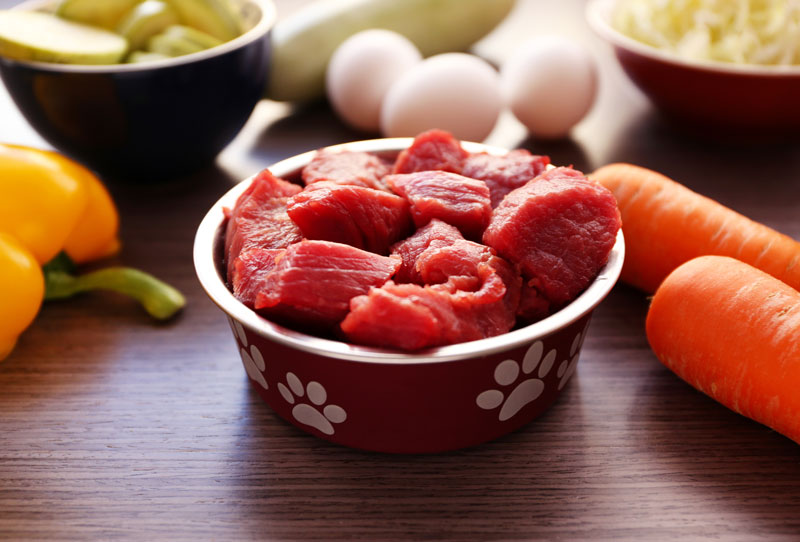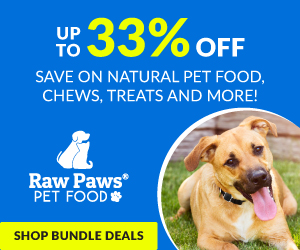Food & Diet
A Beginners Guide to a Raw Food Diet for Your Dog

As a dog owner, of course you want your pet to stay as healthy as possible. A lot of this has to do with the food you give to your dog. There is a wide selection of dog food types and brands out there, so how do you choose which one is best for your furry friend?
Article Overview
What is a Raw Food Diet?
A raw food diet is a more natural option for your dog’s meals, which means that it focuses solely on food that is uncooked and unprocessed.
Some types of food that would typically be found in a raw diet for your dog includes:
- Raw meat, typically from the muscle or other organ meats
- Bones, which can either be ground up or whole
- Some fruits, such as apples
- Some vegetables, including spinach and broccoli
- Raw eggs
- Sometimes dairy products, such as yogurt
Some owners like to prepare their own raw food meals for their dogs, but you can also purchase a brand of pet food with raw ingredients in it to help make the process easier.
Why is a Raw Diet Healthier?
Raw diets are generally healthier than a typical diet because of its benefits to your dog’s overall health. Specifically, it is known for providing the following for your dog:
- Healthier skin
- A shinier coat
- Improved digestion
- Smaller stool
- Improved dental health
- Higher energy levels
- Reduced allergies
- Better weight management
Every dog processes food differently, so all of the above are not guaranteed for every raw diet, but they are common benefits that dog owners have noticed after switching their dog to raw foods.
What Are the Risks of a Raw Diet?
While there may be many positive aspects of a raw diet, there are always some things to look out for. Some risks to be mindful of are:
- Dogs may get bacteria from the raw meat
- Bacteria in foods can also be harmful to humans if they touch it directly
- If you give your dog a raw bone, it may become a choking hazard
- If the raw meals are unbalanced nutritionally, this could be unhealthy for your dog
Many of these risks can easily be avoided with enough research and caution. Every diet comes with some risks, so don’t rule it out simply because of these things. The easiest way to avoid these obstacles is to practice proper food handling and storage, washing your hands, feed in an easy to clean area, and keep backyard clean of poop.
How Much Does a Raw Diet Cost vs. Conventional Dog Food?
Not all raw diets cost the same price, but that being said, raw diets will generally be more expensive than conventional dog food, such as kibble or canned food.
A good rule of thumb is that you will be spending at least an extra dollar or two a day on your dog’s raw food. It may add up over time, but the results are often worth it since it will give you a healthier dog overall.
However, the cost of raw dog food varies based on what you purchase for this diet.
If you buy a brand of raw dog food from a pet store, it is typically more expensive than most kibble. If you find the ingredients yourself at a grocery store though, you can decide what types of meats you’re looking for and where you can find the cheapest raw foods.
Feeding your dog a raw diet doesn’t have to be expensive, it really just depends on how you go about it.
How to Get Started with a Raw Diet
Switching types of foods or food brands can sometimes upset your dog’s stomach. The same is true for switching to raw food because it is likely a drastic change from your dog’s previous diet.
There are a few different ways to go about introducing your dog to raw food.
It is usually a good idea to make the switch gradual to avoid making your dog sick. A puppy or young dog may be able to handle a sudden change in food better, but it can cause diarrhea or vomiting for any dog if the change is too sudden.
A common way to introduce your dog to their new raw diet is to gradually mix the new food in with their old food. Start by mixing in only a small amount, and then work your way up until your dog is eating solely raw food. This will help avoid upsetting the stomachs of more sensitive dogs. This method can also be done by feeding them the two types of foods in separate bowls if you do not want to mix them together.
Most adult dog’s fed DIY raw are transitioned starting with an easy to digest protein such as chicken or turkey. Feed this for a few days to let your dog adjust, if they do well the next step would be introducing a red meat protein, then liver, then other secreting organs.
Basically you want to introduce one new food at time for a few days, if you dog handles it well you can move on to the next food.
Puppies are treated a little differently as their bodies do not regulate nutrients the same way an adult dog’s does. So it’s vital they receive a balanced diet from the start. Starting with a premade raw and following their transition method is advised.
Another easy option to introduce your dog to raw food is to start of by giving the raw food as a treat on the side. Your dog can still eat their normal food, but this way they can get a taste for their new diet before completely switching their meal.
Some dogs may be much pickier than others. If this is the case, then you may want to start by cooking the raw meat first. Many dogs are more used to cooked meat than they are to raw meats. The first time you serve it to them, you should fully cook the meat, but then gradually cook it less and less until you are giving them a completely raw diet.
Remember cooked bones are hazardous, only raw bones should be fed.
How to Maintain Raw Food
Whether it is a brand or raw dog food or a raw ingredient you are using, you should always keep the food sealed when you are not using it in order to preserve the freshness. You should store leftover raw meat in the fridge so that it doesn’t go bad as quickly. If you are using a brand of raw dog food, then it may instruct you to keep it in a freezer instead.
After preparing raw food for your dog, always make sure to wipe down any bowls, plates, or utensils that may have come into contact with the raw meat. This will help prevent bacteria from spreading and harming you or your dog.
If unused after about three days, you should discard your raw meat. You do not want to accidentally feed your dog something that has gone bad.
A Recipe to Get You Started
If you want to create your own raw food for your dog, there are many recipes you can follow. However, a typical raw dog food recipe boils down to:
- One and a half cups of raw meat
- A half cup of vegetables and/or fruit
- Two teaspoons of fish oil
- A vitamin or mineral supplement
This is just a general recipe, so the meat and vegetables that you decide to include are up to you.
Two Most Popular Raw Food Diet Macros
For adult dog’s there are two main methods most people start out at which are Prey Model Raw (PMR) or Biologically Appropriate Raw Foods (BARF).
PMR diets consists of:
- 80% muscle meat, (lung, heart, tongue, are included here)
- 10% edible bone,
- 5% liver
- 5% other secreting organs (kidney, eyes, spleen , testicles, brains, and sweetbreads)
BARF diets consist of:
- 70% muscle meat (lung, heart, and tongue are included here)
- 10% edible bone
- 5% liver
- 5% other secreting organs (kidney, eyes,spleen, testicles,brains, and sweetbreads)
- 7% veggies ( round or puréed)
- 3% fruit (ground or puréed)
Both of these ratio diets usually have an omega 3 fatty acid and eggs supplemented.
In raw feeding we generally feed a percentage of a dog’s body weight, usually at 2.5% and adjusting up or down from there.
These are just two starting points in the raw feeding journey and can be adjust for each individual dog’s need.
Remember that the portions you feed your dog depend on their size. Generally, a dog is supposed to eat just over two percent of their body weight each day.
Check out Raw Fed and Furry instagram to learn more about raw feeding.
Raw Dog Food Brands
If you are looking for a dog food brand that relies solely on raw ingredients, then there are plenty to choose from. Here are a few options to get you started:
Primal
This raw dog food brand provides freeze-dried and frozen options for your dog in a variety of different flavors.
To serve this food, you simply need to break up the pieces and mix them with water. If you choose the frozen dog food option, make sure it is completely thawed before you serve it. Primal also offers other raw treats, such as bones, broth, and bite-sized snacks.
The Honest Kitchen
This brand is one hundred percent human grade. They make sure to include healthy ingredients that customers will recognize and be familiar with. Not only do they provide raw meals, but they also have a wide selection of treats and toppers.
To serve this food, all you have to do is add water to it, and then wait a few minutes for the food to rehydrate.
Stella and Chewy’s
At Stella and Chewy’s, they take raw ingredients and gently bake them to fit your dog’s appetite. It also makes the food less processed and easier for your dog to digest.
Similar to Primal, they provide freeze-dried and frozen nuggets, along with other treat options. They also recommend adding a bit of warm water to the food before serving it.
- Topics:
- Food & Diet



